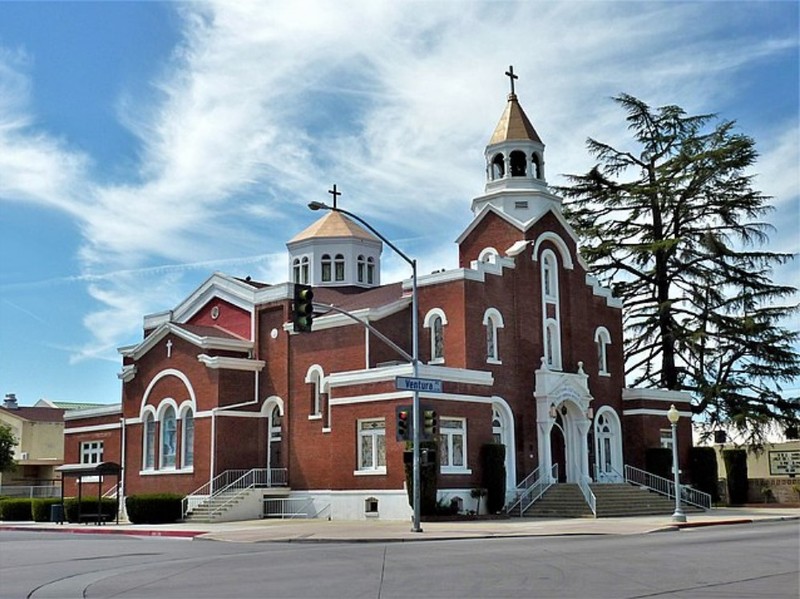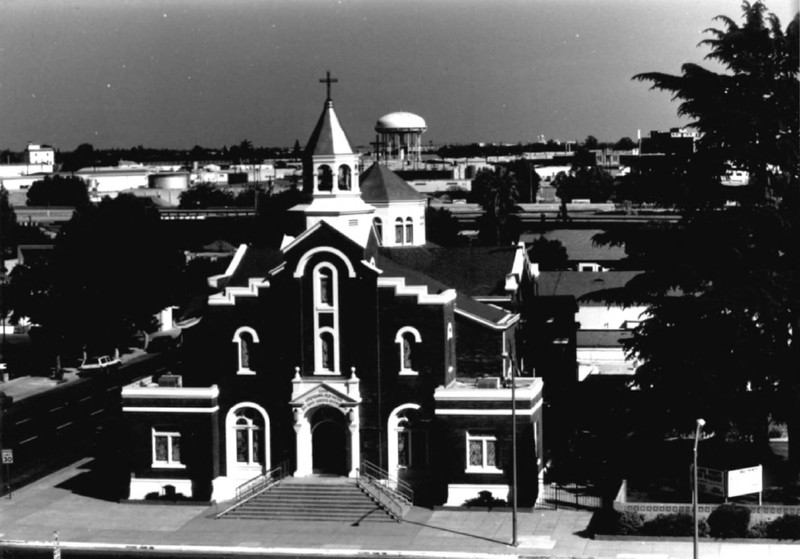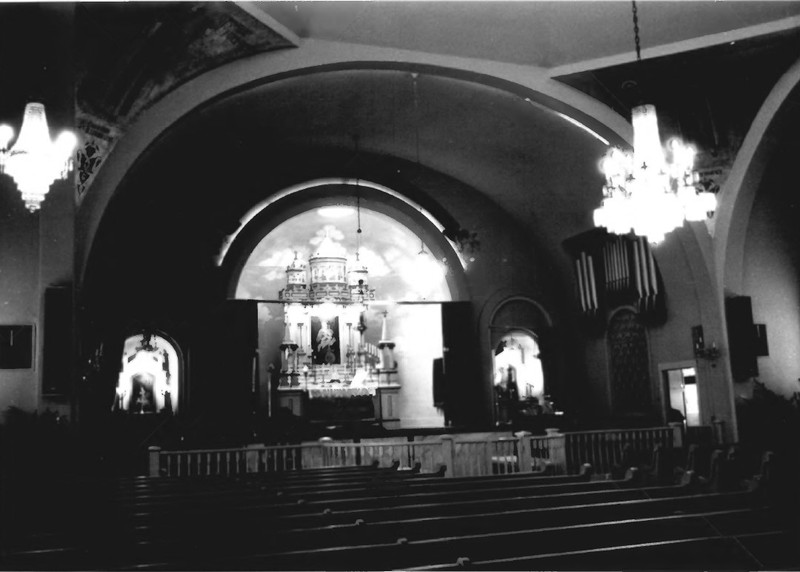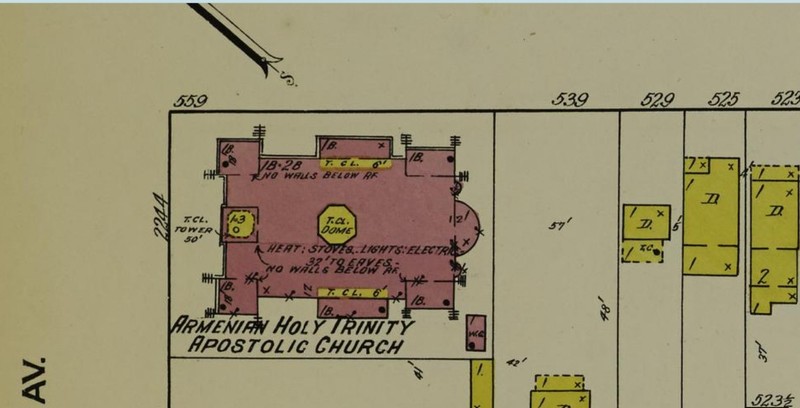Holy Trinity Armenian Apostolic Church
Introduction
Text-to-speech Audio
Built in 1914, Holy Trinity Armenian Apostolic Church is the oldest Armenian church in the American West and may have been the first church designed by an Armenian architect in the United States. The congregation dates back to 1895. Five years later, the members of the church began a fundraising campaign to create their own building. They hired architect Lawrence Karekin Condrajian to design the church, asking for a structure that would resemble the historic churches of Armenia and Turkey. The church served what was once a sizeable Armenian community in Fresno and now serves a diverse community with services being offered in English on the last Sunday of each month. The church was listed in the National Register of Historic Places in 1986.
Images
Holy Trinity Armenian Apostolic Church in 2009 photo (Bobak Ha'Eri)

View of church in 1985 photo by Robby Antoyan for the National Register

View from gallery toward altar in 1985 (Antoyan)

Holy Trinity Church on 1918 Sanborn insurance map (Vol. 1 p. 23)

Backstory and Context
Text-to-speech Audio
Thousands of Armenians settled in the Fresno area in the late nineteenth century, mainly attracted by available work in agriculture. Many became successful businessmen and professionals. By the mid-1910s, there were about 12,000 Armenians in Fresno County and three large churches offering services in their native language. One church was built in Fresno in 1914 on the corner of Ventura and M, Holy Trinity Armenian Apostolic Church. The congregation was established in 1895; their first Holy Mass was officiated by Reverend Aharon Melconian.
The building plans were drawn up by a professional Armenian American architect, Lawrence Karekin Condrajian (1888-1983), based on ancient Armenian churches; the floor plan resembles the shape of an Armenian crucifix. Condrajian (also known as L. K. Cone) was born in Istanbul, Turkey and was educated at an American mission school. After emigrating to America, he trained with architect Henry F. Starbuck in San Francisco; Condrajian moved to Fresno in 1910. He moved to Washington, D.C. in 1927, where he designed post offices, armed forces dormitories, and other buildings for the Federal Government. He returned to San Francisco as the city architect in the 1960s.
Local Armenian residents in Frenso raised the $25,000 needed to build and furnish the church. Another $5,000 was spent to furnish the building; this amount was still owed by the church in December 1914. Construction began on November 1st, 1913; a handful of soil from a monastery in Erzaroum, Armenia and other holy objects were placed in the foundation at the ceremony. Excavations were done in three weeks and construction was started shortly afterwards. The exterior of the massive, red brick church was almost completed by late April of 1914, according to a local newspaper; contracts for plaster work were about to be made. The building was finished in late fall of 1914 and covered about 71 by 103 feet. Archbishop Mousheg Seropian came to Fresno from Boston to preside over the opening ceremonies of Holy Trinity on Sunday, December 13th, 1914. A high mass was celebrated to a full crowd. Reverend Vartan Kasparian from Fresno was the pastor of the new church.
A social hall for the congregation was built in the mid to late 1950s behind the church. Also during the 1950s, many of the Armenian Americans who had settled in the surrounding neighborhood (called "Armenian Town") moved to more prosperous areas of town. Many of the other buildings associated with the Armenian neighborhood have been removed for new development or freeways. Especially popular with church members and residents of Fresno alike is the annual Grape Blessing and Festival, held in August; although hosted by the Men's Society of the church, the festival is usually held at the California Armenian Home. The church's Ladies' Guild holds an annual Food Bazaar in the courtyard. Middle and high schoolers can join the church's Youth Group, started in 1908 by members of the Armenian Language School, the Holy Trinity Boy Scouts, and the Young Ladies Legion.
Sources
Anonymous. "Will Dedicate New Church Dec. 13." Fresno Evening Herald (Fresno) December 5th, 1914. 9-9.
Anonymous. "Activity in City Building Work Continues." Fresno Evening Herald (Fresno) April 25th, 1914. 3-3.
Anonymous. "Complete Laying of Brick on Griffith-M'Kenzie Building...." Fresno Evening Herald (Fresno) November 29th, 1913. 12-12.
Anonymous. "New Church to Be Dedicated Tomorrow." Fresno Evening Herald (Fresno) December 12th, 1914. 12-12.
Anonymous. "New Church is Put into Use." Fresno Evening Herald (Fresno) December 14th, 1914. 4-4.
Antoyan, Robby. NRHP nomination of Holy Trinity Armenian Apostolic Church, Fresno, CA. National Register of Historic Places. Washington, DC. National Park Service, 1985.
Holy Trinity Armenian Apostolic Church. Our Church: Church History, Holy Trinity Armenian Apostolic Church. January 1st, 2023. Accessed May 1st, 2024. http://www.holytrinityfresno.org/.
Holy Trinity Armenian Apostolic Church. Events: Annual Grape Blessing and Festival, Holy Trinity Armenian Apostolic Church. January 1st, 2023. Accessed May 6th, 2024. https://holytrinityfresno.org/annual-grape-blessing-and-food-festival/.
Holy Trinity Armenian Apostolic Church. Church Organizations: Youth Group. January 1st, 2023. Accessed May 6th, 2024.https://holytrinityfresno.org/youth-group/.
State Commission of Immigration and Housing of California. Report on Fresno's Immigration Problem. Sacramento, CA. California State Printing Office, 1918.
https://en.wikipedia.org/wiki/National_Register_of_Historic_Places_listings_in_Fresno_County,_California#/media/File:2009-0725-CA-HolyTrinityArmenianApostolic.jpg
National Park Service (NPS): https://npgallery.nps.gov/AssetDetail/NRIS/86002097
NPS: https://npgallery.nps.gov/AssetDetail/NRIS/86002097
Library of Congress (LOC): https://www.loc.gov/item/sanborn00556_006/
